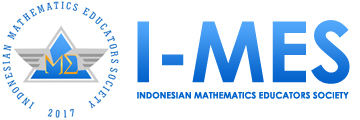Proses Transformasi Visual ke Simbolik Mahasiswa dalam Menyelesaikan Masalah Luas Daerah di Bawah Kurva
DOI:
https://doi.org/10.29408/jel.v7i2.3534Keywords:
mathematical representation, symbolic, transformation, visualAbstract
Mathematical representation is an idea interpretation form of solving mathematical problems. The process of mathematical representation is essential to pay attention to, especially in carrying out transformations between forms of representation, because it impacts the final solution obtained. This study describes the flow of students' thinking in carrying out the transformation process from visual to symbolic representation. This descriptive research was carried out with a qualitative approach. This research phase includes preparing representation tests and interview guidelines, giving tests to 48 students, conducting interviews with selected students based on the accuracy of the mathematical representations produced, and evaluation. The evaluation is carried out by reducing the results of the incorrect representation test, presenting visual and symbolic representation data and the transformation process, and concluding the transformation process. The result of the transformation process from visual to symbolic representation in solving the problem of the area under the curve is carried out with a flow of thought, namely translating the shape of the polygon area into a collection of rectangles, determining the width and length of the partition of the polygon area, and determining the area of the polygon area as a collection of rectangles. In determining the area as a collection of rectangles, there are two different processes, making a mathematical model in the form of sigma notation and addition. This study provides insight into the flow of thinking in changing between forms of mathematical representation in the hope that it can anticipate errors in solving the broad problem under the curve.References
Abdullah, N., Zakaria, E., & Halim, L. (2012). The effect of a thinking strategy approach through visual representation on achievement and conceptual understanding in solving mathematical word problems. Asian Social Science, 8(16), 30–37. https://doi.org/10.5539/ass.v8n16p30.
Astuti, E. P. (2017). Representasi matematis mahasiswa calon guru dalam menyelesaikan masalah matematika. Beta Jurnal Tadris Matematika, 10(1), 70–82. https://doi.org/10.20414/betajtm.v10i1.100.
Boaler, J., Chen, L., Williams, C., & Cordero, M. (2016). Seeing as understanding: The importance of visual mathematics for our brain and learning. Journal of Applied & Computational Mathematics, 5(5), 1-6. https://doi.org/10.4172/2168-9679.1000325.
Boonen, A. J. H., Van Wesel, F., Jolles, J., & Van der Schoot, M. (2014). The role of visual representation type, spatial ability, and reading comprehension in word problem solving: An item-level analysis in elementary school children. International Journal of Educational Research, 68, 15–26. https://doi.org/10.1016/j.ijer.2014.08.001.
Bossé, M., Adu-Gyamfi, K., & Chandler, K. (2014). Students’ differentiated translation processes. International Journal for Mathematics Teaching and Learning.
Bossé, M. J., Adu-Gyamfi, K., & Cheetham, M. (2011). Translations among mathematical representations: teacher beliefs and practices. International Journal of Mathematics Teaching and Learning, 15(6), 1–23.
Chandler, Adu-Gyamfi, B. (2016). Student connections between algebraic and graphical polynomial representations in the context of a polynomial relation. International Journal of Science and Mathematics Education, 15, 915-938. https://doi.org/10.1007/s10763-016-9730-1.
David, M. M., & Tomaz, V. S. (2012). The role of visual representations for structuring classroom mathematical activity. Educational Studies in Mathematics, 80(3), 413–431. https://doi.org/10.1007/s10649-011-9358-6.
Edwards, A. M., & Auger-Méthé, M. (2019). Some guidance on using mathematical notation in ecology. Methods in Ecology and Evolution, 10(1), 92–99. https://doi.org/10.1111/2041-210X.13105.
Fitrianna, A. Y., Dinia, S., Mayasari, M., & Nurhafifah, A. Y. (2018). Mathematical representation ability of senior high school students: an evaluation from students’ mathematical disposition. JRAMathEdu (Journal of Research and Advances in Mathematics Education), 3(1), 46. https://doi.org/10.23917/jramathedu.v3i1.5872.
Frick, A. (2019). Spatial transformation abilities and their relation to later mathematics performance. Psychological Research, 83(7), 1465–1484. https://doi.org/10.1007/s00426-018-1008-5.
Fyfe, E. R., McNeil, N. M., Son, J. Y., & Goldstone, R. L. (2014). Concreteness fading in mathematics and science instruction: A systematic review. Educational Psychology Review, 26(1), 9–25. https://doi.org/10.1007/s10648-014-9249-3.
Göbel, S. M., Moeller, K., Pixner, S., Kaufmann, L., & Nuerk, H. (2014). Language affects symbolic arithmetic in children : The case of number word inversion. Journal of Experimental Child, 119, 17–25. https://doi.org/10.1016/j.jecp.2013.10.001.
Huda, U., Musdi, E., & Nari, N. (2019). Analisis kemampuan representasi matematis siswa dalam menyelesaikan soal pemecahan masalah matematika. Ta’dib, 22(1), 19. https://doi.org/10.31958/jt.v22i1.1226.
Hutagaol, K. (2013). Pembelajaran kontekstual untuk meningkatkan kemampuan representasi matematis siswa sekolah menengah pertama. Infinity Journal, 2(1), 85–99. https://doi.org/10.22460/infinity.v2i1.27.
Ikashaum, F., Mustika, J., Wulantina, E., & Cahyo, E. D. (2021). Analisis kesalahan representasi simbolik mahasiswa pada soal geometri analitik bidang. Al-Khawarizmi: Jurnal Pendidikan Matematika dan Ilmu Pengetahuan Alam, 9(1), 57–68.
Inglis, M., Attridge, N., & Batchelor, S. (2011). Non-verbal number acuity correlates with symbolic mathematics achievement: But only in children. Psychonomic Bulletin & Review, 18, 1222–1229. https://doi.org/10.3758/s13423-011-0154-1.
Joutsenlahti, J., & Perkkilä, P. (2019). Sustainability development in mathematics education - a case study of what kind of meanings do prospective class teachers find for the mathematical symbol "2/3 "? Sustainability (Switzerland), 11(2), 1-15. https://doi.org/10.3390/su11020457.
Komala, E. (2020). Kemampuan representasi simbolik matematik siswa SMP menggunakan blended learning. Jurnal Prisma, 9(2), 204–212. https://doi.org/10.35194/jp.v9i2.1078.
Lestari, K. E., & Yudhanegara, M. R. (2017). Analisis kemampuan representasi matematis mahasiswa pada mata kuliah geometri transformasi berdasarkan latar belakang pendidikan menengah. Jurnal Matematika Integratif, 13(1), 28–33. https://doi.org/10.24198/jmi.v13.n1.11410.29-34.
Luca, S. D., & Pesenti, M. (2011). Finger numeral representations: more than just another symbolic code. Fontiers in Psychology, 2(November), 1–3. https://doi.org/10.3389/fpsyg.2011.00272.
Mataheru, W., Huwaa, N. C., & Matitaputty, C. (2021). Analisis kesalahan mahasiswa dalam perkuliahan matematika dasar secara daring. Jurnal Magister Pendidikan Matematika (JUMADIKA), 3(1), 45–50. https://doi.org/10.30598/jumadikavol3iss1year2021page45-50.
Nurfitriyanti, M., Kusumawardani, R., & Lestari, I. (2020). Kemampuan representasi matematis peserta didik ditinjau penalaran matematis pada pembelajaran berbasis masalah. Jurnal Gantang, 5(1), 19-28. https://doi.org/10.31629/jg.v5i1.1665.
Rahimah, D. (2012). Identifikasi kesalahan mahasiswa dalam menyelesaikan soal-soal pokok bahasan integral pada mata kuliah kalkulus integral. Exacta, X(1), 89–97.
Rahmawati, D., Purwanto, P., Subanji, S., Hidayanto, E., & Anwar, R. B. (2017). Process of mathematical representation translation from verbal into graphic. International Electronic Journal of Mathematics Education, 12(4), 367–381.
Sabirin, M. (2014). Representasi dalam pembelajaran matematika. Jurnal Pendidikan Matematika, 1(2), 33–44. https://doi.org/10.18592/jpm.v1i2.49.
Septian, A., Darhim, & Prabawanto, S. (2020). Geogebra in integral areas to improve mathematical representation ability. Journal of Physics: Conference Series, 1613(1), 012035. https://doi.org/10.1088/1742-6596/1613/1/012035.
Setiawati, F. N., Widadah, S., Nurmala, E., & Agustina, S. (2020). Representasi matematis siswa SMP berkemampuan tinggi dalam menyelesaikan soal matematika. Indonesian Journal of Mathematics Natural Science Education, 1(2), 111–120. https://doi.org/10.35719/mass.v1i2.35.
Tasman, F., Ahmad, D., & Suherman, S. (2018). Kesulitan mahasiswa dalam mengkoneksikan sigma, area, dan definisi integral tentu secara geometri. Jurnal Eksakta Pendidikan (Jep), 2(2), 186-193. https://doi.org/10.24036/jep/vol2-iss2/238.
Trance, N. J. C., Marapo, R. B., & Pornel, J. B. (2012). Students’ visual representation of mathematics. Journal of the Korean Association for Science Education, 32(8), 1318–1332. https://doi.org/10.14697/jkase.2012.32.8.1318.
Utari, R. S., Septy, L., & Hutauruk, L. (2021). Kesalahan pemahaman konsep peserta didik dalam menyelesaikan soal- soal integral lipat dua pada koordinat polar. Inovasi Matematika (Inomatika), 3(1), 51–61.
Downloads
Published
How to Cite
Issue
Section
License
Authors who publish with the Jurnal Elemen agree to the following terms:
- Authors retain copyright and grant the journal right of first publication with the work simultaneously licensed under Creative Commons Attribution-ShareAlike 4.0 International License (CC BY-SA 4.0).
- Authors are able to enter into separate, additional contractual arrangements for the distribution of the journal's published version of the work (e.g., post it to an institutional repository or publish it in a book), with an acknowledgment of its initial publication in this journal.
- Authors are permitted and encouraged to post their work online (e.g., in institutional repositories or on their website) prior to and during the submission process, as it can lead to productive exchanges, as well as earlier and greater citation of published work.
Jurnal Elemen is licensed under a Creative Commons Attribution-ShareAlike 4.0 International License





